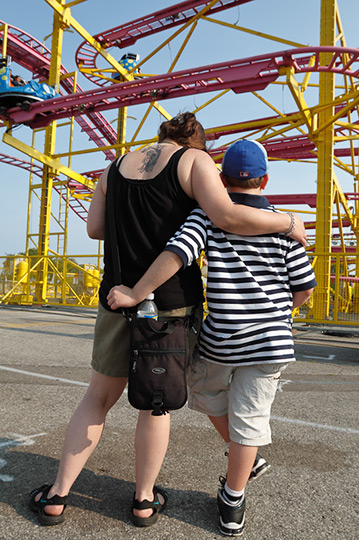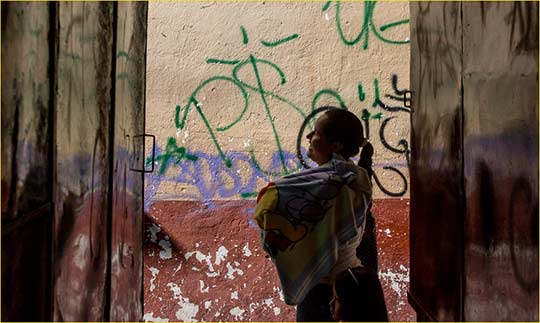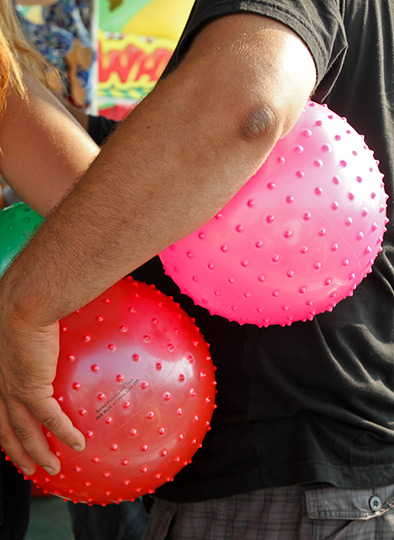
On picking up the new Canon 7D the first thing that one notices is the heft and solidity of the body. This camera is a significant upgrade over all of its predecessors, including the 20D, 30D, 40D, 50D, 5D MKII, and in features even the 1Ds series. In fact it appears to have more in common in terms of build quality with the One Series than with the xxD range.
But, I’m getting ahead of myself. What’s a 7D and why should you care?
The headlines are as follows…
– 18 Megapixel APS-C sized CMOS sensor
– 8 FPS shooting speed
– 19 Cross type Autofocus sensors
– Full HD (1080P) video at 24, 25 and 30 FPS
– Live View with a 3" 920k LCD
– Built-in flash doubles as Speedlight Transmitter
– 100% viewfinder
Not bad, and in fact there’s more, but let’s get down to cases. If you want to read the laundry list of features you can visit any of the camera review sites that provide these at great length. Rather, I think what you came here for is to know what the camera is like to use as – well –a camera. So here it is.
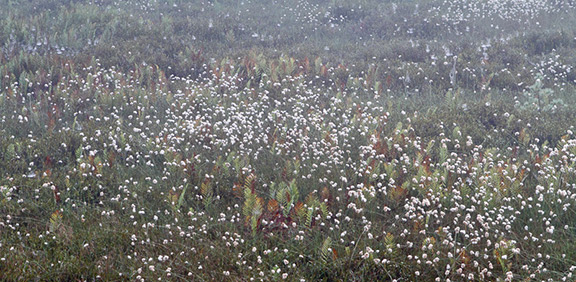
Barrens in Bloom – Muskoka, Ontario. September, 2009
Canon 7D with 24-70mm f/2.8L @ ISO 800
Beta-Sample Image
___________________________________________________________________________________
In Hand
In terms of handling, built quality and features I think it fair to say that the 7D is Canon’s best camera yet. Other than the 1 Series, which are built like the proverbial brick shithouse, lesser models in recent years have always seemed to me to have been built to a price. Nothing cheap mind you – just not as all-of-a-piece as one might wish.
While the 7D is definitely from the House of Canon, and there’s no mistaking the overall design gestalt, Canon has refined almost every detail. Turn on the camera (using the newly positioned power switch at the upper left) and one is actually surprised at its positiveness. Turn the mode dial above it and rejoice in the solid click-stops that simply won’t be accidentally moved to the wrong position, the way all too many cameras are.
I won’t list all of the controls and buttons. You can see some of them them below. What is worth noting is that Live View and Movie mode now have their own dedicated controls. There’s still no dedicated Mirror Lock-Up button (why should we have expected one, given Canon’s historic refusal to do so), and I’ll have more to say about this further on.
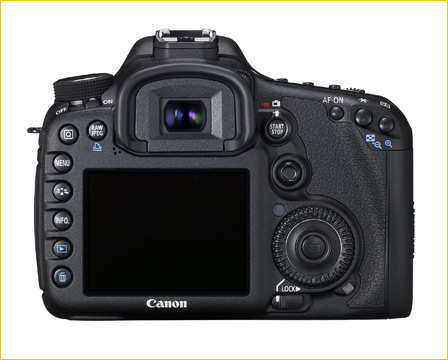
The viewfinder is relatively large and bright for an APS-C sensor equipped camera. Not as big and bright as a full frame camera – how could it be – but pretty good, and with 100% coverage and a 1:1 magnification not too many people are going to be complaining.
The LCD is very good, both in terms of brightness and resolution. I must say though that I think that Canon missed the boat by not having an articulated LCD. This is important when using Live View, and almost a necessity for Movie Mode, as we’ll soon see.
The pop-up flash is as one would expect, though with one big benefit, and that’s that it can now act as a remote speedlight trigger. Great news for flash users.
The CF card door is firm and feels like it will never open by accident, which all too many do as a result of palm friction. The left side of the camera has all of the I/O ports and these are well covered with tethered rubber covers, again an indication that Canon is finally taking the issue of weather sealing more seriously in their sub-One Series cameras.
The top panel LCD is large and full of information. In fact one wag commented that if Canon tries to cram any more information onto it no one over the age of 40 will be able to read it.
I’m also pleased to say that the 7D’s battery is the same LP-E6 lithium Ion battery that has been used in the past few generation of cameras. Battery life seems to be exemplary. After more than 600 frames during my testing the battery indicator was only down by two bars.
I have no inside information whatsoever, but my guess is that the new 7D body design is the template for the eventual 5D MKII replacement. Just replace the flash housing with a full-frame prism. I’m sure there’s a lot more to it that that, but I’ll be very surprised if this isn’t eventually the case.
Mom and Me – Toronto. September, 2009Canon 7D with 16-35mm f/2.8L @ ISO 100
Beta-Sample Image
___________________________________________________________________________________
User Interface
I don’t know. Maybe I’m just becoming an old curmudgeon. But cameras are increasingly becoming computers with lenses attached, and the trend isn’t necessarily producing better devices for making photographs. The Canon 7D comes with a 275 page manual, and needs it. Remember when cameras had an f-stop ring and a shutter speed dial, and didn’t need much else?
Not to pick on Canon, because they do the whole digital interface thing about as well as their competitors. But, therearecompanies who are trying to reduce clutter and control confusion. Leica and Phase One are two such. Phase started this with their P series medium format backs which have four soft keys. That’s it. Leica has followed suite with the S2, similarly with four soft keys surrounding the rear LCD. The Leica M series digital cameras are true to their roots and while they have a few more controls than just the aperture ring and shutter speed dial, they have resisted control-creep.
Back to the 7D. Between the top front dial, the rear wheel and the thumb joystick, navigating through both the top panel controls and the LCD menus works pretty well. Every new camera from Canon seems to refine the interface a bit more (but while also adding features). If you spend enough time with it you’ll eventually learn where everything that you need is, and will learn to ignore those things that you don’t need.
Canon’s "My Menu" is a great help in this regard since it allows you to create shortcuts to those items that you want to access most often. Such as Mirror Lock-Up, which otherwise is buried somewhere in the Customs Functions.
No Virginia, Live View is not a substitute for MLU. I don’t need a bright light (the LCD) shining in my face when all I want to do is lock up the mirror to prevent mirror vibration. Putting it on My Menu is also not a solution since it means sometimes having to scroll through various menus with the joystick before it can be accessed.
Custom Modes are another approach to solving this, and the 7D has three of them on the mode dial. They’re very handy. I like them. But really, why can’t we simply have a MLU button? You know, the one to the left of the eyepiece that is used for Direct Printing – something that surveys show is used by not more than a dozen people world-wide.
Canon understands that this button can be given a secondary function, because on the 7D they have given it the ability to allow shooting raw files as well as JPGs with a single button push. Thank you Canon. Can I now have the ability to turn it into a mirror lock-up button instead? I always shoot raw, and never print direct from the camera, which makes both designated functions completely useless to me. I would hazard, most pros and serious photographers, who are a prime target for this camera, likely feel similarly?
Passing By. CNE, Toronto. September, 2009Canon 7D with 70-200mm f/2.8L IS @ ISO 100
Beta-Sample Image
___________________________________________________________________________________
Shooting Speed
8 FPS is pro quality shooting speed. I was curious to see what the sustained rate would be though. I timed 39 frames in 10 seconds in combined raw and Fine JPG and 79 frames in 30 seconds. It seems that once the buffer is full the camera can shoot at about 2 FPS, which is the speed at which it can write its buffer. This is using an Sandisk Extreme IV card, with UDMA, capable of a write speed of 45 MB/s.
___________________________________________________________________________________
Autofocus
Canon has had to take a bit of a rap for autofocus issues in recent years. With the 7D they appear to have pulled out all of the stops, with a new autofocus system featuring 19 AF points, all of them cross sensors. This should make it one of the most sensitive and fast responding systems on the market.
During my brief time testing the 7D I was only able to do some mundane focus testing in low light, or of fast moving subjects, such as passing cars, and in every test the 7D performed admirably. I may not be the best person to test an AF system though as my personal preference is to either manual focus or to use a single center point triggered when needed by my thumb, rather than my shutter release finger. Over the years I’ve found that AF systems, not matter how good they are, can’t think, and instead simply decide to focus not on what I want them to but on what is the highest contrast subject in the field.Mother please – I’d rather do it myself.
___________________________________________________________________________________
Movie Mode
When Canon introduced video recording on the 5D MKII they excited a great many people. Amateur photographers thought it kind of cool, but industrial, broadcast and Indy video makers jumped all over it, as did some Hollywood productions. The combination of a huge sensor (in video terms) and low price, and pretty decent video quality was a winner. This is the case because when shooting video / movies, narrow depth of field is a critical component of how one tells the narrative. Camcorders, no matter how many bells and whistles they may have, still have tiny sensors, the way digicams do, and this DOF is too large for most serious production needs.
The first 5D MKII was crippled in terms of video by having only 30 FPS (not 24 or 25, which filmmakers want), but also only could shoot in fully auto mode. Earlier this year Canon pleased many by providing a firmware upgrade that allowed the 5D MKII to shoot video in manual mode, and the 7D now comes with this capability.
My time with the camera didn’t allow for more than cursory testing of its video functionality, but I was impressed by what I saw. Combined with the new Live View control, a dedicated Movie shooting button, and 1080P/24FPS, this makes the 7D a killer video camera for those that are looking for this functionality.
My biggest functional disappointment with the 7D in terms of shooting video is that the LCD is fixed. Really Canon! What were you thinking? Didn’t your focus groups tell you how important this is? You make video cameras as well. They ALL have articulated LCDs. It’s a must. So, why leave it off the 7D, which may well be the best video DSLR to date from any manufacturer?
But all is not gloom and doom. I was particularly impressed with the 7D’s ability to shoot stills while shooting video. Well, not quite "while". If you are recording video and press the shutter release, a still image or images are taken while the video pauses, and then the movie making continues as soon as the buffer has finished writing. Very nicely done.
The 7D requires fairly fast CF cards to shoot video, and has an in-viewfinder indication of when the video buffer is overflowing due to a slow card. I never saw this, as I used fast cards, but it’s nice to know that it’s there.
There is a built-in mike, and a speaker, but for decent quality audio you’ll need to add an external mike and mixer. There is no recoding of audio with stills, as there is on 1 Series cameras. A shame really, since this is so useful a feature, and it seems to have been omitted simply to keep from encroaching on 1 Series territory.

Click the above to play a one minute video example
shot with the 7D, at 24P
___________________________________________________________________________________
Raw Files
While I’m on a rant, let me rant about raw files. Of course the 7D has a unique raw format, just as with every single one of the hundreds of cameras from the major Japanese camera industry. This means that the most popular raw processing programs such as Adobe Lightroom, Photoshop Camera Raw, Apple’s Aperture, Phase One’s Capture One, and DxO can not currently process 7D raw files.
They will eventually, but for the next few months it means having to use Canon’s DPP software. UPDATE: The latest Camera Raw now unofficially supports the 7D. No profiles yet, but better than nothing.
DPP has gotten better. I’m sure it does and always has done a very fine job of processing Canon raw files. But, do we really need to have 10 new versions a year, one for every new camera brought to market? DPP used to be truly dreadful in terms of interface and workflow. Now its at least tolerable, but it’s not really even in the same league as the majors in terms of usability and productivity.
So, once again, a plea from photographers for Canon, Nikon and the others. Please adopt an open standard for raw files. I want to use your cameras but I don’t want to use your software. Face it. These just aren’t up to par.
DNG is here. It works, and works well. It’s being adopted by more and more camera makers. Get on the bandwagon and put your user’s needs first. Thank you. Rant mode off.
Oh yes – one more thing. Since installing DPP on my 15" Macbook Pro I am experiencing regular crashes of Lightroom, Photoshop and Capture One. Not DPP itself, and not any other software other than raw processors. Now, I’m not accusing anyone of anything, and I’m only saying…….
Having a Ball. CNE Toronto. September, 2009Canon 7D with 16-35mm f/2.8L @ ISO 100
Beta-Sample Image
___________________________________________________________________________________
Image Quality
Though Canon placed no restrictions on my ability to report on image quality, other than to indicate that any pictures shown are "Beta Sample Images" I am going to punt, and will not be describing in any detail the image quality that I have seen from the Canon 7D.
Frankly, the reason is that I am seeing things which I am not sure are a consequence of the camera’s inherent characteristics or are specific to pre-production cameras or even this specific camera. This includes overall image softness and some digital artifacting. Nothing terrible mind you; just enough though that I am aware of it, and therefore don’t want to make any undue assumptions.
The major camera technical review sites will have their in-depth analysis of full production cameras soon enough, and once you’ve been able to read a couple of them you’ll be able to draw a pretty good conclusion about this for yourself.
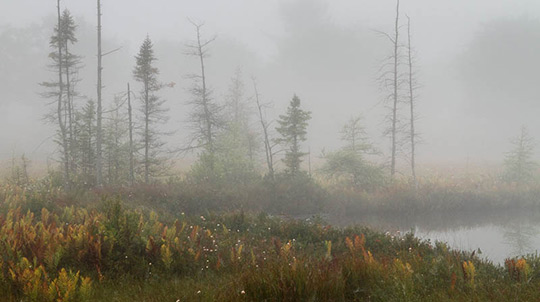
Barrens #3. Muskoka, Ontario. September, 2009
Canon 7D with 24-70mm f/2.8L @ ISO 200
Beta-Sample Image
___________________________________________________________________________________
Without being able to consider image quality along with build quality and features I really am unable to summarize my thoughts on the 7D. If production cameras are as good as we all hope they can be, and as good as the construction quality of the camera, then Canon will have a total winner in the category and at this price point. The 50D left a somewhat sour taste in some people’s mouths. Let’s hope that when it ships the 7D does Canon proud.
September, 2009
You May Also Enjoy...
Palm software for photographers
Owners ofPocket PCscan find a review of comparable programshere. Focus+For many photographers the passing of the days when all lenses had depth of field scales
